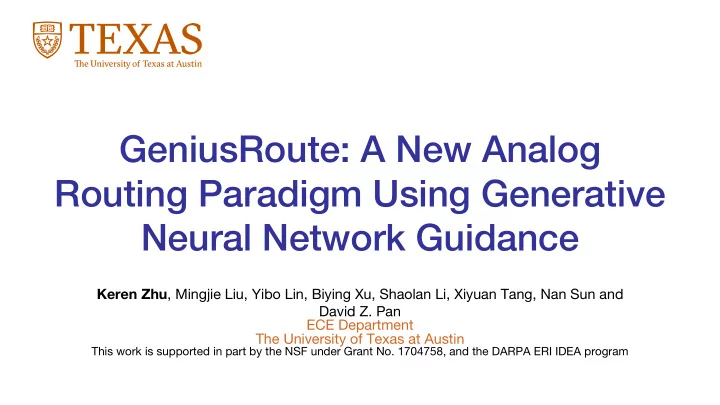

GeniusRoute: A New Analog Routing Paradigm Using Generative Neural Network Guidance Keren Zhu , Mingjie Liu, Yibo Lin, Biying Xu, Shaolan Li, Xiyuan Tang, Nan Sun and David Z. Pan ECE Department The University of Texas at Austin This work is supported in part by the NSF under Grant No. 1704758, and the DARPA ERI IDEA program
Outlines • Introduction and Problem Formulation • GeniusRoute Framework • Experimental Results • Conclusion
High Demand of Analog/Mixed-Signal IC • Anything related to sensors needs analog! Communication • Internet of Things (IoT), Sources: IBM autonomous and electric Advanced computing vehicles, communication and 5G networks… Healthcare 3
A Bottleneck in IC Design: Analog/Mixed-Signal Analog parts of IC take large design efforts A major reason: analog circuit layout is usually done manually [IBS and Dr. Handel Jones, 2012] 4
Typical Automatic Analog Circuit Design Flow Front-end • Automated analog design often Electrical Design consists of front-end and back-end flows • Physical design (back-end) is separated in placement and routing Back-end Physical Design 5
Analog Routing Problem Placement Routed Layout
Challenges in Formulating Analog Routing Problem Symmetry constraints are widely accepted [Ou et al., 2014] Shielding, No standard rule for additional Avoid active region, constraints. Design-dependent. … Automatically learn from human layouts? 7
Emerging Machine Learning Applications Lithography: GAN-OPC Physical Design: WellGAN [Yang et al., 2018] [Xu et al., 2019] 8
Automatically Learn Guidance from Human Layouts • Learn routing guidance • Where the human would likely to route the nets • Extract training data from labeled layouts • Apply learned model to automatic routing as guidance 9
A ML-Guided Routing Problem Heuristic constraints: use a set of detailed heuristics as routing constraints Placement Explicated Constraints Routing Conventional Approach Routing guide: routing strategies learned from human Symmetric Constraints + Placement Routing ML-based Routing Guide GeniusRoute Approach 10
The GeniusRoute Flow • Learn from GDS layouts • Pre-process layouts into images • Predict routing probability using autoencoder • Use prediction as detailed routing guidance 11
Generating Images with Generative Neural Network
Data-Preprocessing: Extracting Routing from Layouts Extract “pins” and routing of nets Three categories of models: • Symmetric nets • Clocks • Power and Ground 13
GeniusRoute: Learning Routing Patterns from Human Training Phase Do we have enough data? Inference Phase Trained 14
3-Stage Semi-supervised Training Algorithm • Labeled layouts are hard Unlabeled Unsupervised Data Pre-train to get Neural • Could rely on unlabeled Network data to help train the model Supervised Labeled Training Data 15
Stage 1: Unsupervised Feature Extraction using VAE Use cheap unlabeled data to learn a general feature extraction Extracted Features 16
Network Architecture: Unsupervised for Stage 1 Conv Conv FC Conv Conv Conv Conv 17
Stage 2: Supervised Decoder Training Fix the feature extraction to learn the generative model Extracted Features 18
Stage 3: Supervised Decoder Fine-Tune Fine-tune the network for better accuracy with lower learning rate Extracted Features 19
Network Architecture: Supervised for Stage 2&3 FC Conv Conv Conv Conv 20
Framework Implementation and Environment Setup • Data preprocessing: C++ • ML model: Python with Tensorflow • Router: Modified maze routing in C++ • Simulation: Cadence ADE simulator with TSMC 40nm PDK
Experimental Result Examples Ground Truth Model Output Prediction Routed Layout 22
Experimental Results: Simulation Results • Test on comparators and OTAs • Evaluate with post layout simulation • Compare with manual layout and previous methods COMP1 Schematic Manual w/o guide GeniusRoute Offset (uV) / 480 2530 830 Delay (ps) 102 170 164 163 Noise (uVrms) 439.8 406.6 439.7 420.7 Power (uW) 13.45 16.98 16.82 16.8 Closer results to the manual layout 23
Experimental Results: More Simulation Results COMP1 Schematic Manual w/o guide GeniusRoute Offset (uV) / 480 2530 830 Delay (ps) 102 170 164 163 Noise (uVrms) 439.8 406.6 439.7 420.7 Power (uW) 13.45 16.98 16.82 16.8 COMP2 Schematic Manual w/o guide GeniusRoute Offset (uV) / 550 1180 280 Delay (ps) 102 196 235 241 Noise (uVrms) 439.8 380.0 369.6 367.8 Power (uW) 13.45 20.28 20.23 20.15 OTA Schematic Manual wo/ guide GeniusRoute Gain (dB) 38.20 37.47 36.61 37.36 PM (degree) 64.66 72.46 94.68 76.40 Noise (uVrms) 222.0 223.7 292.7 224.8 Offset (mV) / 0.88 3.21 0.39 CMRR (dB) / 59.61 58.52 59.15 BW (MHz) 110.5 102.5 232.1 107.3 Power (uW) 776.93 757.35 715.11 787.82 24
Conclusion GeniusRoute • A new methodology to automatic learn from human layout and apply in automatic flow • Semi-supervised learning algorithm for data-efficiency • Experimental results show closed-to-human post layout simulation Future directions • How to overcome the challenge of obtaining human layouts for labeled data 25
Thank you!
Recommend
More recommend